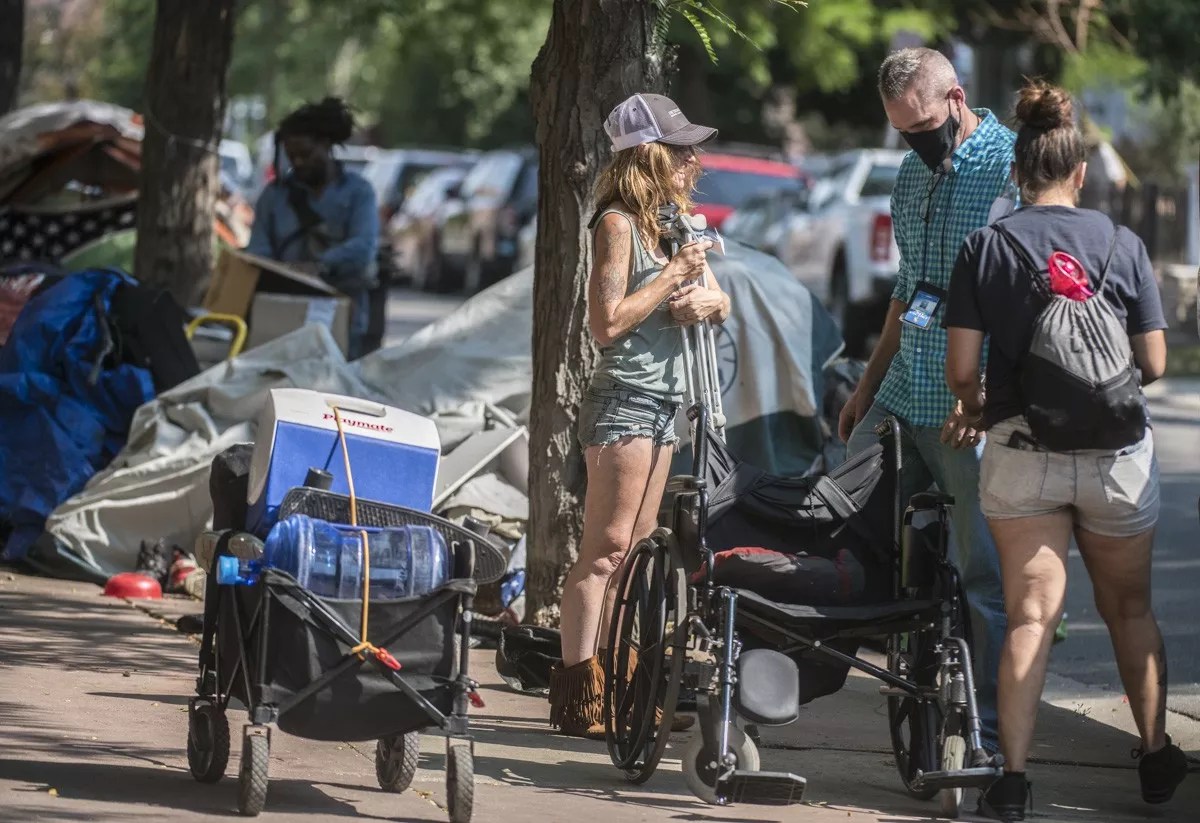
Evan Sem

Audio By Carbonatix
Over the past two weeks, two large homeless encampments in the core city were cleared out: one at Lincoln Park, in front of the Colorado State Capitol, the other eight blocks away, at Morey Middle School. But many of those who were dispersed simply moved to another spot a few blocks away and set up their tents again.
During the coronavirus pandemic, encampments have sprung up not only on streets in and around downtown, but in other spots in the metro area. “We’re seeing more visible homelessness as people are seeking out groups, seeking out safety, but also sharing information and sharing resources, especially right now when there’s so much uncertainty going on,” says Marisa Westbrook, a Ph.D. candidate in the Department of Health and Behavioral Sciences at the University of Colorado Denver.
The majority of the encampments are in central Denver, though, and while much larger than in past years, they’re not a new phenomenon, according to a study Westbrook conducted with a colleague, which was recently featured in the Journal of Social Distress and Homelessness. That study, which has been cited in legal challenges to Denver’s urban camping ban, asked 484 individuals experiencing homelessness who were sleeping outside in late 2018 and early 2019 “why they sometimes choose to sleep in core-city, highly visible areas,” according to the Journal piece.
The responses indicated that many people prefer sleeping with groups downtown “because they feel safe and protected among friends in well-lit and warmer locations,” the study determined. In fact, about half of all respondents cited safety as the main reason that they stay with a visible group downtown.
Additionally, 64 percent of those who answered the survey reported that they “have been separated from their group due to police telling the group to break up or move along. In response to such orders, homeless residents report that they frequently leave behind the security of groups and the safety of well-lit downtown areas: 49.7% seek more hidden and isolated city locations to sleep, 22.9% seek out hidden river or creek beds, while 24.3% choose to keep moving all night,” the study noted.
“The sweep itself is so traumatizing. They’re being told people don’t want to see them. I think the first instinct is to try to find somewhere to hide, maybe down by the river, or down in alleys,” says Cathy Alderman of the Colorado Coalition for the Homeless.
Explains Westbrook, “Overall, you see a lot of people reporting that when they are asked to move along, when they are separated from groups, they find themselves feeling less safe in those locations.”
And that feeling is backed up by data. “Homeless persons who move often to avoid police contact are more
than twice as likely to be physically assaulted than those who do not report moving to avoid police contact, and 39% more likely to be robbed than homeless persons who don’t move to avoid the police,” according to the study. As a result, they frequently return to core-city encampments.
Service providers suggest another reason that people gather downtown: its central location.
“People tend to camp downtown because it’s closer to services,” Alderman says. “It’s generally closer to grocery stores and convenience stores and places where they can get food and provisions and things. And then, just from a transportation perspective, especially right now, trying to make sure that they don’t have to go quite as far to access RTD makes a lot of sense.”
Denver officials frequently point out that on any given night, there are hundreds of shelter beds available in the city. But many homeless individuals have continued staying outdoors, whether because of barriers to entering shelters, which have rules regarding pets and belongings, or simply because they prefer living outdoors. The pandemic has added another layer of concern, as some people are afraid of contracting COVID-19 in an indoor setting.
One way that the city and service providers are attempting to address such concerns is by establishing a handful of temporary safe camping sites throughout the city for the remainder of the pandemic. The Centers for Disease Control and Prevention recommends that municipalities not disperse encampments, so sanctioned camping sites would help the city abide by these guidelines…after they’ve already swept other spots, however. Service providers would staff the sites, each of which could house up to sixty people, and there would be sinks, showers and toilets.
The Denver Coliseum parking lot had emerged as the preferred first location for a site. However, neighborhood opposition scuttled that recommendation, and also pushed back the debut of the first Safe Outdoor Spaces spot, originally slated for mid-August. Service providers are now eyeing state-owned land; Governor Jared Polis has said he’d consider that, but no deals have been struck.
“I hope that the governor will take the chance to be a part of the solution,” says Alderman.